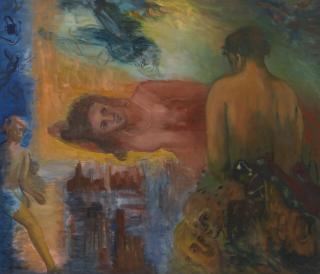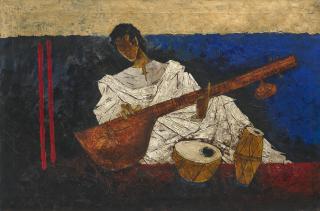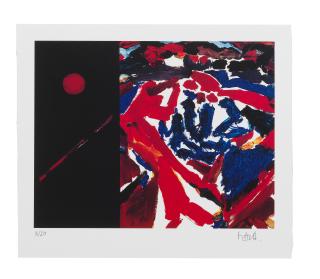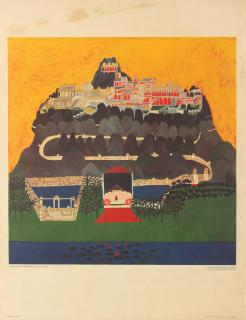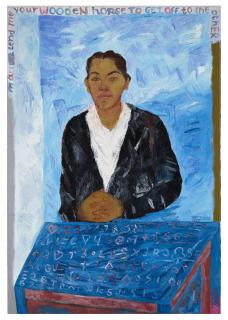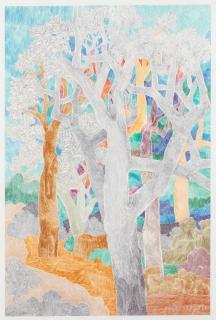Nalini Malani born 1946
The artist Nalini Malani
- One of the most influential Indian artists of the 20th century.
- Known for her cross-media »video/shadow plays«.
- Understands being an artist as social activism.
Nalini Malani's artistic work is influenced by her childhood experiences as a refugee. She was born in British India in 1946, a year before the country's independence and partition into India and Pakistan. Malani's family fled the now Pakistani city of Karachi first to Calcutta and a few years later to Mumbai, where they lived in a colony for forcibly relocated Sindhi. During her student years in the 1960s, Malani maintained a studio where artists, musicians, and theater practitioners could work alone as well as collaboratively.
After graduating, she experimented with photography and film, but focused mainly on painting with acrylics and watercolors. Early on, Malani's emphasis on mythological female figures, feminism, and the rejection of nationalism became apparent. In 1985, she organized the first exhibition in India in which only women were allowed to exhibit. The success of this presentation led to a traveling exhibition in public venues that provided a counterpoint to elitist art galleries.
In the early 1990s, Malani radically changed her artistic direction: the violent clashes between Muslims and Hindus in Mumbai, in which some 900 people died, had such a lasting effect on her that she focused on religious disputes. Malani developed performances and video art based on her own drawings. The multi-channel video works, for which she invented the term »video/shadow play«, often look like moving graffiti. Increasingly, Malani is also concerned with the effects of war, capitalism, and environmental degradation. She is influenced by experiences in India and Europe, where she lives alternately.
In 2013, Malani was one of the few women to win the Fukuoka Prize in the Arts and Culture category. This prize honors individuals or organizations that work to preserve or develop the culture of Asian countries. Many world-renowned museums list works by Malani in their collections, including the Centre Pompidou, the Museum of Modern Art in New York, the National Gallery of Modern Art Mumbai, and the British Museum.
Die Künstlerin Nalini Malani
- Eine der einflussreichsten indischen Künstlerinnen des 20. Jahrhunderts.
- Bekannt für ihre medienübergreifenden »Video/Schattenspiele«.
- Versteht das Künstlerdasein als sozialen Aktivismus.
Nalini Malanis künstlerisches Schaffen ist geprägt von ihren Kindheitserlebnissen als Flüchtende. Sie wurde 1946 in Britisch-Indien geboren, ein Jahr vor der Unabhängigkeit und Teilung des Landes in Indien und Pakistan. Malanis Familie flüchtete aus der nun pakistanischen Stadt Karatschi zunächst nach Kalkutta und einige Jahre später nach Mumbai, wo sie in einer Kolonie für zwangsumgesiedelte Sindhi lebte. Während ihrer Studienzeit in den 1960er-Jahren unterhielt Malani ein Atelier, in dem Kunstschaffende, Musizierende und Theaterschaffende allein sowie gemeinschaftlich arbeiten konnten.
Nach ihrem Diplom experimentierte sie mit Fotografie und Film, konzentrierte sich aber hauptsächlich auf die Malerei mit Acryl- und Wasserfarben. Schon früh zeigten sich Malanis Schwerpunkte auf mythologische Frauenfiguren, Feminismus und der Ablehnung von Nationalismus. 1985 organisierte sie die erste Ausstellung in Indien, in der nur Frauen ausstellen durften. Der Erfolg dieser Präsentation führte zu einer Wanderausstellung an öffentlichen Orten, die einen Gegenpol zu elitär geprägten Kunstgalerien bildeten.
Anfang der 1990er änderte Malani ihre künstlerische Ausrichtung radikal: Die gewalttätigen Auseinandersetzungen zwischen Moslems und Hindus in Mumbai, bei denen etwa 900 Menschen starben, wirkten so nachhaltig auf sie ein, dass sie sich auf religiöse Auseinandersetzungen fokussierte. Malani entwickelte Performances und Videokunst, die auf ihren eigenen Zeichnungen beruhten. Die vielkanaligen Videoarbeiten, für die sie den Begriff »Video/Schattenspiel« erfand, wirken oft wie sich bewegende Graffiti. Zunehmend beschäftigt sich Malani auch mit Auswirkungen von Krieg, Kapitalismus und Umweltzerstörung. Beeinflusst wird sie dabei von Erfahrungen aus Indien und Europa, wo sie abwechselnd lebt.
2013 konnte Malani als eine der wenigen Frauen den Fukuoka-Preis in der Kategorie Kunst und Kultur gewinnen. Mit diesem Preis werden Individuen oder Organisationen geehrt, die sich für die Bewahrung oder Entwicklung der Kultur asiatischer Länder einsetzen. Zahlreiche weltbekannte Museen verzeichnen Werke von Malani in ihren Sammlungen, unter anderem das Centre Pompidou, das Museum of Modern Art in New York, die National Gallery of Modern Art Mumbai und das British Museum.
Nalini Malani in a nutshell
According to our databases, prices at auction range from a few thousand to just over $100,000. Manipulating Reality from a Christie's auction in 2010 brought $122,500.
Most of her exhibitions so far have been in Mumbai, India. However, she has been a frequent visitor to Europe and the U.S., for example, Turin, Paris, London, Porto, Dublin and New York. There have also been some presentations in New Zealand, Australia and Mauritius.
Häufige Fragen zu Nalini Malani
Laut unseren Datenbanken bewegen sich die Preise auf Auktionen zwischen wenigen tausend bis knapp über 100.000 US-Dollar. Manipulating Reality von einer Christie’s-Auktion aus dem Jahr 2010 brachte 122.500 US-Dollar.
Die meisten Ausstellungen gab es bisher in Mumbai in Indien. Sie ist jedoch häufig zu Gast in Europa und den USA gewesen, zum Beispiel in Turin, Paris, London, Porto, Dublin und New York. Einige Präsentationen gab es auch in Neuseeland, Australien und Mauritius.
Nalini Malani quotes
Zitate von Nalini Malani
Nalini Malani in News and Exhibitions
National Gallery Contemporary Fellowship Exhibition
In the Sunley Room of the National Gallery of London, beginning March 2, visitors will view an endlessly programmed panorama of animations by artist Nalini Malani – My Reality is Different is an exhibition of the first National Contemporary fellow. Malani dates Old Masters up and provides a view of people on the margins of society.
Nalini Malani in News and Exhibitions
Ausstellung zum National Gallery Contemporary Fellowship
Im Sunley-Saal der National Gallery of London betrachtenden die Besuchenden ab dem 2. März ein endlos programmiertes Panorama aus Animationen der Künstlerin Nalini Malani – My Reality is Different ist eine Ausstellung der ersten National Contemporary Stipendiatin. Malani datet Alte Meister up und gibt den Blick frei für Menschen am Rande der Gesellschaft.

